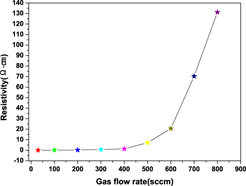Article contents
Effect of growth gas flow rate on the SiC crystal resistivity
Published online by Cambridge University Press: 03 July 2012
Abstract

A technique of controlling growth gas flow rate for adjusting crystal resistivity is presented in this paper. The experimental results showed that high growth gas flow rate could affect SiC crystal resistivity remarkably. The SiC crystal resistivity would get higher and higher with increasing growth gas flow rate. The purifying effect of gas flow rate was contributing to resistivity increase at a relatively low flow rate range. As for the high gas flow rate, increase of resistivity might be explained by the well-known site competition effect. Then, one explanation for reducing nitrogen content in the crystal via increasing gas flow rate was put forward. Namely, the Si component in the gas species may more easily go through the graphite crucible at the initial stage to make the growth ambient C-rich when the gas flow rate is ∼800 sccm or more and hence suppress nitrogen incorporation into carbon site to increase crystal resistivity. This result is very helpful to grow high purity high resistivity SiC ingots.
- Type
- Articles
- Information
- Journal of Materials Research , Volume 28 , Issue 1: Focus Issue: Silicon Carbide – Materials, Processing and Devices , 14 January 2013 , pp. 23 - 27
- Copyright
- Copyright © Materials Research Society 2012
References
REFERENCES
- 1
- Cited by


